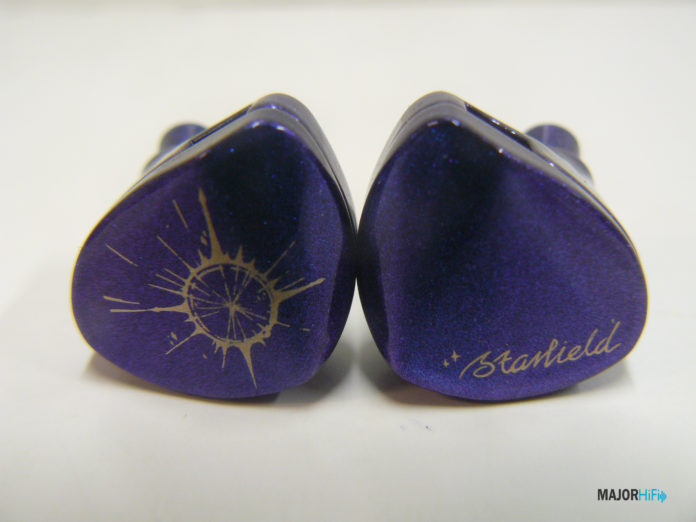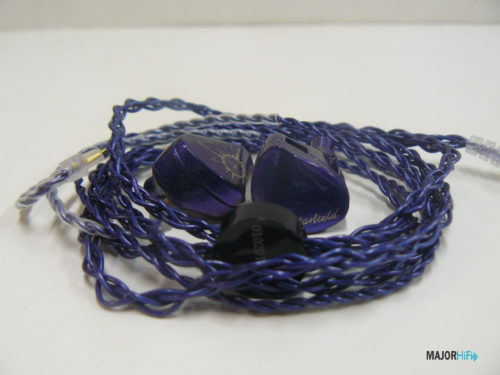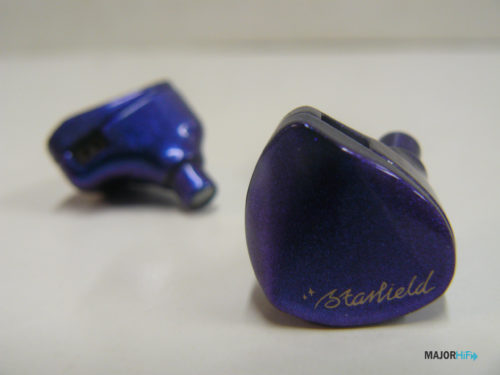Moondrop has been one of the standout brands for me this year. As they’ve gained popularity in the consumer and audiophile world, we here at MajorHiFi have been excited to try out more selections from their library of IEMs. This time I was able to get my hands on the Starfield, a sort of older sibling to the Aria, which is one of my personal favorite IEMs that you can get for less than a hundred bucks. The Starfield just crosses that price tag at $109.99. Does it sound any different?
What You Get
The Starfield comes in a standard long box that contains a few notable accessories. Of course, you have the cable, which is 4N OFC Litz with a 3.5mm termination. This is a lot more ordinary IEM cable than what’s offered with the Aria, giving you a thinner braid with a plastic sleeve. You get the same case as the Aria though, a circular zip-up case with a few sets of silicone ear tips in a tiny ziplock bag. Lastly, Moondrop gives you a pair of tweezers for some serious IEM cleaning.
Look and Feel
When it comes to design, the Starfield definitely pops. Its shape is similar to the Aria, but with a glittery blue hosing in place of a black one. It’s also a bit more angular than the Aria and in my opinion an easier fit within the ear. My only issue with it is that my Final Audio ear tips sometimes feel off of the spout when inserted in my ear, but the Starfield comes with enough of their own tips that will fit better anyway. The outer shell sits in your concha naturally and was never a bother to me throughout my many hours of listening.
Design
In terms of its configuration, the Starfield is constructed using a 10mm dynamic driver with a weave carbon nanotube array diaphragm. This gives the Starfield superior stiffness and toughness, all while shaping different analytical characteristics to the sound signature. It’s also dampened by a gold-plated brass inner chamber that helps smooth and balance the signal. A magnet coil also supports this system by improving transient response and dynamic range.
Soundstage
If you’re familiar with the Aria’s soundstage, the Starfield will feel right at home. When I initially heard the Aria I was shocked by its level of width and depth for the price point. Hearing a similar level of scale for the Starfield is less surprising to me, but still leaves me completely satisfied. Although some of the stereo imaging is linear, the localization of elements creates a larger sound field for the music to occupy. Plenty of headroom is granted, even when exhibiting a more minimal sense of height. You still get great dimension in the soundstage due to the Starfield’s impeccable imaging. It establishes immersion while adhering to a strict positioning that makes its layers easy to identify.
Low End
With the low end, some of the frequencies take some time to really resonate in the sound signature. However, once the tone blooms outwards, it delivers clarity and texture to the music. It lifts the timbre considerably, subtlely shaping the tonality of the frequencies in a way that’s clear and effective. Just enough presence is heard to make a considerable impact on the sound signature. It’s capable of adding just noticeable sweeteners like rumble and vibration, but I wouldn’t say it adds much depth to the timbre in any way.
Mids
The midrange accomplishes much more tonal richness within the sound signature, offering natural characteristics and depth. Its timbre allows the frequencies to produce a lot more layers for a more spacious response that still feels full and put together. These details are revealed a lot quicker than the bass, as the mids resonate with a much more intense transient response. This makes instrumentals perform more sharply, adding crispness to their tone, and with added dimension where distance is properly communicated. Vocals are forward and sit a little above the mix for added transparency and more enticing performance.
Highs
Treble frequencies fall right in line with the mids, completing an accurate, life-like sound signature in an enticing way. The tone is smooth but isn’t afraid to accentuate some of its details. It forms a more gripping timbre that’s very easy to listen to while performing clean textures as opposed to ones that are overly bright and harsh. High piano notes that ring out were a big standout for me personally, adding spark and definition to their harmonic content.
Summary
I’m a big fan of these affordable Moondrop IEMs. It feels great to listen to an IEM like this that sounds better than it has any right to be. Having heard the Aria before it, whether or not I fully recommend the Starfield is a bit more complicated, as I don’t believe this is a significant upgrade. However, the Moondrop Starfield is still a generously priced IEM that’s easy to recommend.
| Pros | Cons |
|
|
The Moondrop Starfield is available at Audio46.
MAJORHIFI may receive commissions from retail offers.












